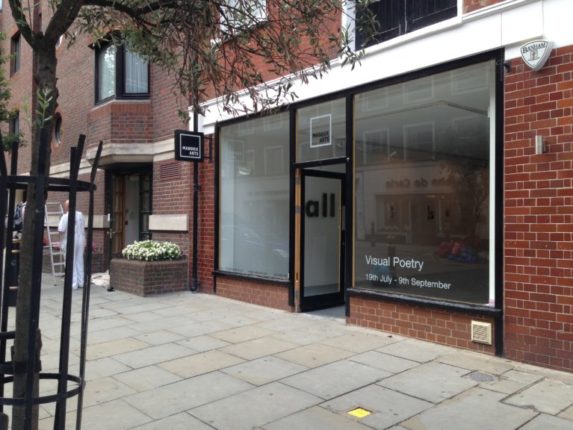Exhibitions - Visual Poetry: The experimental path of inter-media traditions in Latin America
Exhibition: 19th July – 9th September 2013
Artists: Iván Capote, Lenora de Barros, Augusto de Campos, Wlademir Dias-Pino, León Ferrari, Glenda
León, Clemente Padín, Julio Plaza and Marcelo Sahea
Maddox Arts is proud to present Visual Poetry curated by Gabriela Salgado. An exploration of the interplay between images and words- Visual Poetry presents the foundation for an artistic language where words function as signifiers beyond the images they evoke, inviting us to read, hear, watch and even touch the ‘poem-object’. The progenitors of this movement can be traced to Latin America’s inter-war years when a generation of artists under the influence of the European avant-garde began an inter-media discourse that would span the course of the century, evolving to meet the concerns of each generation.
Poesia Concreta, was a poetry movement founded by the Noigandres group poets Décio Pignatari and the brothers Haroldo and Augusto de Campos in São Paulo in the early 1950s alongside its visual counterpoint, Arte Concreta. In the programmatic opening statement of the catalogue Arte Concreta: Objeto e Objetivo, Décio Pignatari wrote: “Verse having been abolished, Concrete Poetry confronts many of the problems of space and time (movement) that both visual arts and architecture have in common”
By the 1970s, in the midst of military dictatorships imposed on most South American countries, artists began to create strategies of communication that attempted to undermine the controls of oppressive censorship and increase connectivity with the wider art world, creating a network that could be said to serve as an analogical precursor of the internet. ‘Mail art’ became one of the main vehicles for the distribution of artworks in the context of political repression, serving as a ubiquitous platform for subverting the strictures of government and bypassing the printed media and other state controlled circuits. Uruguayan artist Clemente Padín alongside artists from Argentina and Venezuela formed the Asociación Lationamericana de Arte Correo – the group believed in ‘an art from the base upward, without artists’ that manifested in a critique of society, politics and the rigidity of the commercial art world.
Lenora de Barros Photopoemas are potent examples of Poesia Concreta’s diversification into other mediums in the second half of the 20th century. In her photographic polyptych POEMA (1979) she playfully explores the relationship between the acts of writing and the primary organ of communication- the tongue. On a similar tangent León Ferrari uses Braille, the written language for those of impaired vision, and inscribes its characters made of raised dots onto ready-made images, associating touch and vision to images as means to summarise an idea.
In the 21st century, Glenda León and Iván Capote stand as the frontrunners of a new generation of Cuban artists continuing to build on the legacy of visual poetry. Capote’s deployment of sculptural language utilizes a refined simplicity to wring out a tender poignancy via material tautology and the formal associations between language and image. In Otoño (All Fall) the ‘F’ letter cast in steel has seemingly fallen to the ground leaving the viewer to ruminate on the surviving ‘..ALL’
Marcelo Sahea employs the language of the digital era to produce synthetic visual poems that exist in the interface of VJing, sound, video and performance, incorporating looping and repetition as strategies to propose the viewers a novel relationship with the semantic, aural and visual qualities of poetry. His Poegif series are looped animated words and images inducing a trance-like contemplation that the artist enhances through vocal performance.
